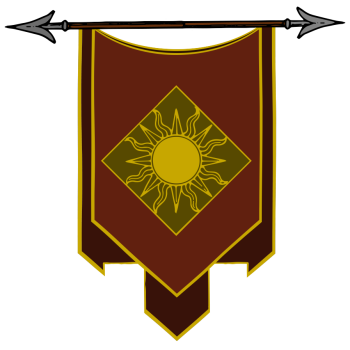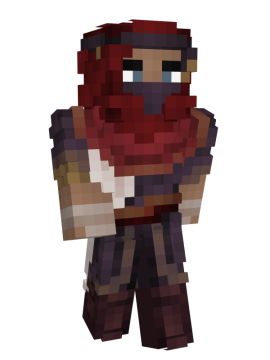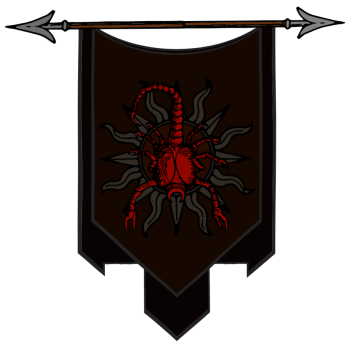Kha'mal
Introduction
"In the Anjyarri desert, beneath the sun's bright light, the Kha'mal traverse the sands. They roam the shifting dunes of the breathless, windless night, brandishing weapons and armor coated in black and gold. And sometimes, in ghastly dry voices, they whisper a tongue mostly forgotten by man. Worshipping forgotten deities, kings, and queens as their guards, which will grant them the death they so seek, for their past has long since been forgotten and is waiting to be reborn." - Unnamed Azari'lunn scholar of Al-Jabrid
Appearance
The Kha'mal tribespeople are diverse in height and skin tone, similar to the eclectic Vaemir Khadan tribes spread across the desert and those under the rule of the Dark Elves. Their hair can range from straight to wavy and from fine to coarse, varying in colors from dark blond to black. The eye color of these Khadan is primarily hazel; however, the women in the Kha'mal tribes tend to reveal glittering pools of green, blue, or even stark black. Their skin tone varies the same, with the majority of the population in these tribes being olive-toned; they, too, can range from tan to dark-brown skin.
Apparel
Similar to the Khadan Vaemir kin, the Kha'mal tribes cover themselves in cloaks seen in many colors. Many Kha'mal warriors among the tribes were seen in bright clothing, such as scarlet robes. They often decorate themselves with golden ornaments, such as collars, jewelry, and corsets of overlapping brazen plates; they braid their hair with gold. Some tribes paint their bodies or add tattoos referencing their past or an ancient deity. Women in the tribes prefer to keep their hair long, as beauty and the well-being of their bodies are kept in high-standard shape. Like the warriors, the women decorate their long hair in braids, jewelry, and gold. The warriors of the Kha'mal tribes are described as wearing various armor, no tribe being the exact same. However, their main comparing feature is the lightly worn gold-colored plating. The armor of the Kha'mal is primarily made from bronze or brass-colored metal, and the helmet is designed to be worn over the headscarf. The helmets are often decorated in style to intimidate the enemy. It featured cheek-and-eye guards and horns resembling a scorpion or other ancient creature from their mythology. Some speculate these armor pieces are relics of their past, re-used for the same purpose during combat. Yet, the Kha'mal in service of the ruler of Anjyarr, the Kataphracts, are the best equipped. Their golden or brass overlaid steel lamellar armor consisted of many pieces covering the body's vital regions while staying lightly armored to traverse the fast dune seas of Anjyarr. Underneath, the warriors of the Kha'mal would wear leather boots and tunics or cloaks to cover the remaining exposed parts, sometimes including facecloths and gloves. Heavily armored fighters often include pieces of chainmail around the arms or torso. Not all tribes would have access to this armor; however, some preferred turbans. The color of said tunics and cloaks varied. The standard would be white, resembling a warrior, while red would be a veteran or leader in the tribe. Black would be those of the highest honor: guarding a sacred tomb or temple. The female servants of the ruler of Anjyarr would be spotted thanks to their fitted golden masks resembling a stoic expression, which was to hide the face from the population during service.
Culture and Society
Languages
The language spoken in the Kha'mal tribes originates from an ancient form of Anjyarri, which is called Akhadi. Being a pluricentric language similar to the modern day Anjyarri language, the main speech is still somewhat recognizable. Many nomads or citizens who encountered the tribes describe the voices of Kha'mal as sounding harsh and like "shouting beasts". However, the Kha'mal are quiet yet very expressive folk in their daily lives, which is a side not many get to experience due to their isolated lives. While not in combat, warriors tend to speak in a low, raspy voice, close to a whisper, making their presence somewhat stand out due to their silence. This, merged with Akhadi, makes it hard to determine what they say, amplifying their eerie presence.
So far, only a few words are stated to be originating from the Akhadi language. Comments from the Kha'mal language, such as "Kaf'hyr" and "Aykyri" seem to be cursive or descriptive words towards a person. "Aykyri" is used mainly towards people not originating from Anjyarr, speculating this word to mean "outsider" or "foreigner".
Demographics
Among the various nomadic tribes that still roam the endless dunes of the Anjyarri desert is a group of Khadan that is almost shrouded in legends and myths. Birthed from the remnants of the Golden Age, one now known for their warbands and nomads, its people clad in brass and gold-colored armor, protective over the various temples and tombs that now crumble and sink between the dunes of the western desert. The Kha'mal, as they are known, are amongst the most ancient of people. Their past is shrouded in mystery, forgotten over centuries by both man and god. To them, knowledge is power, and their personal goal is to safe-keep and continue their people's past. It is believed they are among the Khadan Vaemir kin due to their appearance and region of inhabitation. It is unspecified whether the Kha'mal tribes of the first centuries were the primary ancestors of those that later formed the various tribes.
The Kha'mal use tactics common among nomadic tribes that rather live in seclusion other than in the open. However, their combination with warfare has perfected their ability to use the dunes and desert weather to their advantage. In truth, the Kha'mal are expert horsemen and tamers of beasts, warriors using camels and horses to travel vast distances through the sand. Their communities are never settling in one place, permanently on the move. But not all of their tribes are the same, and with Khadan as prior dwellers, even Tieflings and Dark Elves are glimpsed among them in very rare occasions. Many believe in the "Old Path" and see various figures as their deities that have otherwise been forgotten, some even tied to the tombs spread across the mountain and dune regions of Anjyarr. A large group of these Kha'mal have eventually begun servicing the head of the Anjyarr realm: The Sultana. It has become quite common for many of these tribes to eventually migrate to the cities.
Celebrations
The Kha'mal celebrate many feasts and holidays like most Khadan. While the main population under the rule of the Azari'lunn celebrate in unity and friendship, the Kha'mal tribes often prefer to celebrate in isolation from outsiders. However, it is not uncommon for the nomads to flock to the cities to join the festivities.
Kura
The Kha'mal celebrate this festival about the love of life in the Khadan's philosophy, be it a bit changed due to their different view of faith. A defining trait of this festival is that various activities occur throughout the day. Starting in the morning, the youth would put on sporting shows such as horse archery to display the following line of warriors and their skills. The old would visit their friends and family, then later at night is the time for couples to gather together and single people to search for mates, which often ends in feasts around fires.
Anor-Sa
Anor-Sa, also known as the Day of Prayer, is a day entirely devoted to the Kha'mal way of worship toward death. At the end of the month, on this day, the Kha'mal tribes pray throughout most of the day or perform rituals towards the various deities. Some prefer to isolate themselves, while others come together to hold sermons or ceremonies, sometimes near ancient tombs or shrines. Many devote this day to offering gifts or prayers to the nation's ruler, who some see as one of these deities. To disturb someone's prayer or a rite on this day is seen as the highest of insults, as their view on life and death means a lot to the tribes.
Itekh Akhin
The duels of Akhin date back to the warriors' past of the Kha'mal. Seen as a day to memorize the warriors who made the journey to the afterlife, either through combat or self-sacrifice, in the tombs now buried in Anjyarr, the Itekh Akhin is a day where the soldiers would hold trials and ceremonies to earn their "Warrior-Marks". These trials and rituals would come in the form of blessings of armor and weapons and duels with sharpened knives. Warriors would strip down to their undergarments and engage in high-stakes fights, which end when one of the opponents either yields or is defeated. After said duel, the victor would let his wounds heal naturally to show that he was victorious, leaving a natural scar line. The one who lost would rub his injuries with the sand or mud of the duel area, causing his scars to turn ugly and gray. Thanks to these "Warrior-Marks", the warriors could keep track of their battle honors and gauge each others' prowess. The duels taking place in the cities are open to the public, making this, to many unknown with the Kha'mal way of life, a spectacle.
Romance, Marriage, and Reproduction
The Khadan, in general, value loyalty to a very high degree. The values of romance, family, and faith are significant to the Kha'mal culture. To the Kha'mal, the continuation of their culture, religion, and people is the highest priority of the tribes; hence marriages are both out of love and survival. Families help each other and work together, and all tasks fall equally on both the men and women of a family.
In the nomadic culture of the Kha'mal tribes, it is a custom for the men to take the first steps to women. Women in the Kha'mal tribes are fit for marriage at the age of 16 and are often set in arranged marriages. However, those living in the cities have also taken the more modern marriage customs from the main population of Anjyarr.
Warriors wanting to marry need to offer a trophy collected from a battle to the woman's family, which shows their dedication to the bond they wish to tie in the marriage. Men would even compete in either duels or a display of wealth to impress the family and the future wife, which can take quite a selection of time before the marriage occurs. The head of the woman's family then asks the lady for her opinion, and when agreeing to marry, she is given a betrothal necklace.
A betrothal necklace is a hand-carved piece of jewelry young men offer to the women they intend to marry. The future husband is to carve a unique design from stone and fasten it to a choker, thus creating a necklace. The engagement becomes official once the necklace is worn; thus, the jewelry signifies to other prospective suitors that the woman is spoken for.
Marriages and ceremonies can take weeks, even months, before it finally concludes. During the weeks, both families celebrate together in many traditions. This ranges from friendly duels of the men of both families to decide who is the strongest to the women together making new jewelry and clothes to gift to one another. Men of both families often travel together on a pilgrimage, called the Mah'ka, to the nearest temple or tomb to pray for the couple and the future of both families, which then ends in a feast back home.
When it does so and concludes, the entire tribe often celebrates the union of two families and a new generation to be born in a feast called the Ni'hayat or Hayat. During said feasts, they often sacrifice an animal or object to a deity of choice to secure a wealthy future or in honor and thanks to the Sultan. The betrothed lady is dressed in the most beautiful attire both families can offer or design, often shades of white and red and covered in traditional jewelry. Both man and wife receive Ahahn, a form of decorative body paint on the hands and arms, painted on them by a member of the family, often a mother or sister. The bride then waits at the altar, letting the groom come in last. The wedding officiants are often high-ranked warriors or priests of their tribe, but if none were available, it was often the oldest of both families that would officiate. However, it is not uncommon for the nomads to marry in the cities or close to the tombs they so cherish. This form of ceremony and weddings dates back to the ancient Empire. Some even further. Few of these traditions have been adopted by the modern day citizens of Anjyarr and have become more common.
Same-sex relationships among the Kha'mal are uncommon for those still wandering the dune sea. However, those now embracing modern city life have become more accepting. Yet, due to the tradition around continuing the culture and history of their people, it is frowned upon by many and, in extreme cases, even seen as taboo and punishable.
Death and Funerals
The Kha'mal have similar ideals compared with the rest of the Khadan of Anjyarr regarding death. "The Path", as the common belief is dubbed, is about finding inner peace and believing to be reincarnated. However, the Kha'mal believe in the theory of ascending to godhood, or immortality, which is the greatest gift someone can receive. To the tribes, this is a gift for staying true to yourself, living your life till death to the fullest, in service to their deities. Often, Khadan of these tribes would pray or commit rituals next to great tombs to honor or worship these figures, wishing them a beautiful death, a life of peace in the underworld, and sometimes rebirth.
The Kha'mal believe in an ancient form of “The Path”, known simply as “The Old Path”. This alteration of faith has many more gods and figures that the Khadan of the tribes worship, including their ascension and return to Eden. Upon someone's passing, depending on their status, the higher-known Kha'mal would be wrapped in either white or red robes after the body had received its painted markings. The marks tell the person's deeds and performance in life, depending on their role in society, from the commoner to the warrior to a priest. After those rituals, the robes would be decorated with the person's wealth and offerings of their close ones; gold, clothes, weapons, or armor. Often, flowers and herbs would be added as sufficiently. The decorations tell the gods who this person was to assist them in the afterlife and ascension. There are multiple ways a ceremony may end. To the warriors, their bodies are cremated on the place where they passed, which was often the battlefield, or their bodies would be entombed in small formations made of clay or sandstone. To the ordinary Kha'mal tribe member, the body would receive the honors the passed wished for. This can vary to burial or cremation.
The burial takes place in the location they have passed, as the tribes are always on the move; their sites fade away through time. When cremated, their ashes are put in decorative clay urns and are either taken with the family, buried in the desert, or placed near the tomb or shrine of their deity. Only a member of the tribe is then allowed to eventually remove the urn and spread its ashes into the rivers of Anjyarr. It is also not uncommon to be embalmed and later entombed, for it is believed they keep the bodies in shape until their time of ascension comes. This, however, is only done to the highest figures of the Kha'mal society. This ritual refers to their past, where kings and queens would do the same in their pyramids and temple cities. Khadan, in general, do not mourn their dead for long, and the Kha'mal are no exception, for they believe their loved ones are now in the hands and guidance of the gods.
History
WIP


